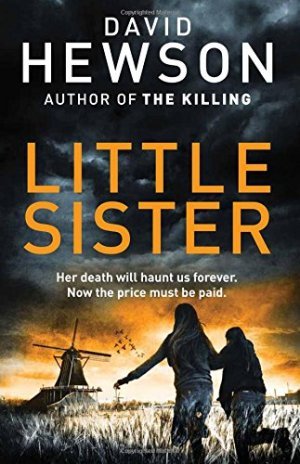
This third police procedural in Hewson’s Netherlands series again features Amsterdam police brigadier Pieter Vos and his misfit Frieslander colleague, Laura Bakker. The story centres on the plight of Mia and Kim Timmers, orphaned twins – originally from a set of triplets – who have been institutionalised for a decade in a remote facility for young female mental patients deemed dangerous. Ten years earlier, when the girls were 11, their parents and the third triplet, Little Sister Jo, were murdered by parties unknown. That same night lead singer of the local pop band The Cupids was murdered and the girls accused of the crime.
Now there’s a problem. The girls have aged out of their facility and the psychiatrist in charge says they are no longer a danger. Despite the director’s reservations and rather than finding a new institution for them, they are released. It’s a good study of the kinds and extent of evil that can occur when society judges some people not worth caring about and turns its back. Is what happens to them hidden or just not seen? Locating the institution on the island of Marken, connected to land and normal Dutch life by only a thin thread of road atop a grassy dyke, is symbolic as well as plot-relevant.
As in the earlier books in the series, The House of Dolls (2014) and The Wrong Girl (2015), Vos lives on his decrepit houseboat with wire-haired terrier Sam. Hewson’s descriptions of Amsterdam when Vos is walking Sam, for example, and of the part of the country where the sisters are from – the Waterline – are created with admirable atmospherics. He ably summons the low, flat, green country, its dykes and lakes, a land criss-crossed with sparkling channels where “life teemed beneath the emerald surface and nothing was quite what it seemed.”
The culture of the small town of Volendam, where the girls lived and the initial murders occurred, is far removed from the sophisticated city. It’s clever that Bakker, who is usually a fish out of water on Amsterdam’s police force, is best able to communicate with the rural Waterland people. Hewson has given characters unique occupations that reflect their environs: Willy and Tonny Kok remove blockages from the channels protected by the narrow dykes, and it’s they who find the half-submerged car belonging the male nurse assigned to drive the twins to an Amsterdam halfway house.
Instead, the girls travel to the city by bus and make their way to a house whose address has been mysteriously left for them along with money and a map. Now disconnected from official supervision, the runaways are free but not free, because the house’s occupant keeps almost as close an eye on them as they experienced in Marken. Ultimately, there’s a scene in that house that is an homage to Tess of the D’Urbervilles, which Thomas Hardy fans will appreciate.
The body of the nurse is found buried in the sand of the Marken beach, and before long, another corpse is discovered. Did the girls do all this? Any of it?
Secrets highly placed people have tried to hide for a decade are bursting to come out. They aren’t revealed in the police records relating to the pop star’s murder, however, because those have disappeared. Again and again, the evidence Vos and Bakker seek remains out of reach.
Because this is a multiple point-of-view story, you’ll have a few more puzzle pieces than they do, which doesn’t necessarily make it easier to solve. Hewson provides plenty of interesting suspects, though some of them appear rather intermittently, and I had occasional difficulty recalling their identities. Although the Little Sister is enjoyable, it seems about 50 pages longer than it needs to be, with some motivational untidiness around the climactic scene.
Hewson is an accomplished crime writer, perhaps best known for rewriting Danish TV thriller The Killing as an award-winning novel, and he’s interviewed here about that project. He also has worked with Shakespeare scholar AJ Hartley on novelisations of Hamlet and Macbeth. I have listened to the Macbeth, narrated by Alan Cumming, and his descriptions of the three witches are truly harrowing. He brings that same ability to describe an environment in which difficult choices become inevitable to the story of Mia and Kim Timmers.
Macmillan
Print/Kindle/iBook
£6.99
CFL Rating: 4 Stars








